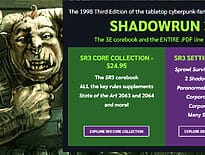
Last article, I looked at the ‘Thinimblin Line‘ – how a game can become burdened by it’s own backstory and continuity. How you can eventually gather enough lore and story that it becomes to much for players to absorb.
Games become info dumps for new players and massive lore searches for existing players.
We briefly talked about how this can signal the end of a campaign’s attractiveness to new blood, which is one of the ways we protect a game group against sputtering out.
Remember our intent here is not to destroy or end a campaign. We are just thinking about its continued health and how once it becomes a game that is too folded up it’s own lore, that can be derailing or confusing. Too many options, factions and directions can paralyse decisions. Too much lore can prevent a forward movement because the past is so heavy. So what do we do?
The Supernatural Approach: Raise The Fence

Supernatural was a show that ran for a long time. It had 15 seasons. At some point during that, the show stopped being interested in telling a story to new audiences and completely embraced its fanbase, delivering shows for the faithful.
And this is totally an option you can take with a game.
You’ve created a heavy amount of continuity and lore, but it’s ok because the game is designed for the players in it. As long as they get it, no one has to worry. You’re telling a story to these people, and you don’t really care if new people want to play.
This is a legitimate stance and the one that requires the least work. As long as you don’t foresee a situation where you might need to replace dropped players or have people bring friends who might get lost, then it might be the choice.
Hell, even lean into that deep lore and use it to fuel what’s going on. But it runs the risk of a game-ending unexpectedly because it has no ‘refresh’ button.
The Star Trek Approach: Partition

Star Trek has massive lore and backstory. But one of the genius things it did was sort of reset itself on the regular, focusing whole seasons of a show or and entire show around specific threats and ideas. These were then bolted on to a familiar chassis that didn’t require too much work.
You don’t need to understand how Cardassians work in order to watch Voyager, or Discovery. In fact, it’s not necessary to understand how Kazon society works in order to enjoy later seasons of Voyager because they stopped featuring them.
Sometimes, introducing a new corner of lore and new concerns is the best way to stop a game becoming too bogged down in continuity. Have the next arc take place in a location no one knows, with ideas and characters we’ve never met and maybe aren’t connected to the ongoing plot. It allows new players to have a corner of the world they can really get to grips with before returning to a bigger canvas and gives campaign veterans the chance to find out new stuff and get that ‘discovery’ kick they may have lost.
Another part of this is to actually finish some of the threats and arcs in your game. For the first 13 levels of one D&D campaign, the main focus of my game was the plots of a group known as The Coin and a mastermind beholder. Eventually, the players defeated these foes and while we occasionally get reminders or feel the fallout of those plots, the later tiers of the game have introduced new and more dangerous foes. The players know that The Coin is over and the beholder is long dead. It feels resolved. It allowed us to move on and only occasionally use that part of the continuity. Learning to let go of stuff can really help.
The Walking Dead Approach: Scorch The Earth

After eight seasons of The Walking Dead, the show was burdened with a lot of continuity. People had complained they kept moving from place to place but now, after 3 seasons of the show staying in the same places and establishing communities that would stand, the show couldn’t just leave things in the dirt.
So they did something very different for the 9th season. They got rid of a crucial character, put in two time jumps and blew a lot of stuff up they had in place. It wasn’t a complete reset, but quickly shifted the understood rules of show and narrative.
Other shows have done this before, the last season of Angel, basically the end of any The Good Place season (Or frankly, any episode of that show) has rug pulls that leave the viewers in a whole new world and set-up.
In an RPG, this sort of scourging can be damaging if handled wrong. But if you are careful and precise, you can sweep the board in a fell swoop. For those who watch anything Critical Role related, the burning of Emon by the Chroma Conclave is a great example of this.
Taking everything everyone knows and just wiping the slate clean can really provide a gut-wrenching moment for long-term players but also clear the decks of continuity in a really compelling way that invites new players into the games. If you are looking to introduce a new player, the wake of a shared tragedy can really be a good motivator.
I think it’s worth mentioning that no matter where you are in a story, if you’re feeling bogged down by the weight of what has gone before, there’s always a way out. You can always make something new, or shift the focus if it’s not working. You shouldn’t be tied to lore, even if you made it. Introduce something new that doesn’t make sense, surprise your players. If something doesn’t fit the lore, they’ll tear your game apart to find out why. In doing so, you can reorder stuff so it is less confusing, or shake the need to understand so much lore by making it less relevant.
Until next time, I wish you clear and easy games!
🤖AI Disclosure. Software helped create images in this post. Geek Native's AI Content Policy.

